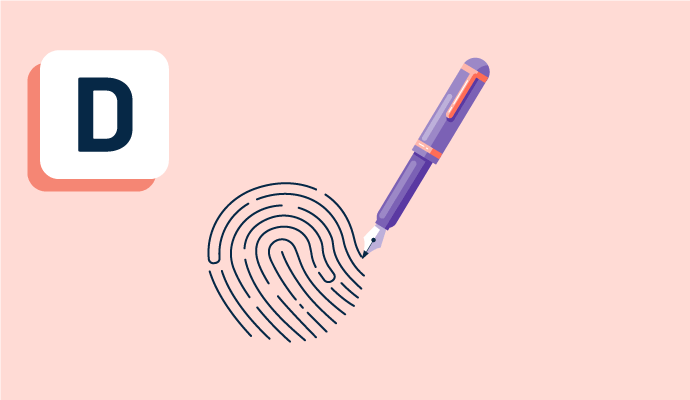Was ist Dokumentensignierung?
Dokumentensignierung ist der Prozess des Hinzufügens einer digitalen oder elektronischen Signatur zu einem Dokument, um die Identität des Absenders zu bestätigen. Die elektronische Dokumentensignierung eliminiert die Notwendigkeit physischer Papierdokumente und beschleunigt den Signaturprozess erheblich.
Dokumentensignierung ist oft ein kritischer Bestandteil eines jeden Vertrags und spielt eine wichtige Rolle im Bereich der Vertragsmanagement-Software und Angebotssoftware. Die Dokumentensignierung rationalisiert den Dokumentenfluss mit mehreren Funktionen, die darauf ausgelegt sind, die Dokumentenerstellung zu vereinfachen, Arbeitsabläufe zu etablieren und Parteien daran zu erinnern, unterzeichnete Dokumente einzureichen. Viele Branchen, einschließlich Banken und Immobilien, sind auf die Dokumentensignierung angewiesen, um ihre täglichen Geschäftsabläufe zu unterstützen und Verträge zeitnah abzuschließen.
Arten der Dokumentensignierung
Unternehmen verwenden verschiedene Formen der digitalen Dokumentensignierung, um unterschiedliche Arten von Verträgen und Dokumenten abzuschließen. Es ist wichtig, sowohl die Software zu verstehen, die den Benutzern die Möglichkeit bietet, Dokumente zu signieren, als auch die verschiedenen Standards, die für die Dokumentensignierung festgelegt wurden. In Bezug auf Software gibt es im Allgemeinen zwei gängige Typen:
- E-Signaturen: E-Signaturen sind die häufigste Methode, ein Dokument elektronisch zu signieren, was durch die Nutzung von E-Signatur-Software erreicht wird. Es handelt sich um eine digitale Form einer Signatur, die rechtlich bindend und sicher ist, jedoch keine Kodierung oder Standards beinhaltet. Unternehmen verwenden E-Signaturen, wenn sie nur das Dokument verifizieren müssen. Zum Beispiel kann eine E-Signatur eine Fotokopie einer handschriftlichen Signatur, eine getippte oder gezeichnete Signatur oder sogar nur das Klicken auf einen „Akzeptieren“-Button umfassen.
-
Digitale Signaturen: Digitale Signaturen sind eine weitere gängige Form der Dokumentensignierung, aber im Gegensatz zu E-Signaturen sind digitale Signaturen im Allgemeinen sicherer. Bei einer digitalen Signatur müssen Benutzer ein digitales Zertifikat besitzen, damit sie mit dem Dokument verknüpft werden können. Eine digitale Signatur wird oft von Zertifizierungsstellen autorisiert, die für die Bereitstellung digitaler Zertifikate verantwortlich sind, die mit Lizenzen oder Pässen verglichen werden können. Ein digitales Zertifikat wird verwendet, um das Dokument zu validieren und seine Authentizität zu bestimmen. Dies ist entscheidend, um die Identität der ursprünglichen Person mit der Signatur zu überprüfen.
Zusätzlich zur Software gibt es auch verschiedene Standards, die in Bezug auf Sicherheit und Gültigkeit für die Dokumentensignierung festgelegt sind. Diese Standards werden durch die Vorschriften der Europäischen Union festgelegt und werden weltweit langsam übernommen. Diese Standards sind wie folgt:
- Standard-Elektronische Signaturen: Standard-Elektronische Signaturen erfordern keine Benutzer-ID-Verifizierung. Sie können mit E-Signatur-Software verwendet werden und umfassen gescannte Signaturen und die Verwendung eines „Ich akzeptiere“-Buttons.
- Fortgeschrittene Elektronische Signaturen (AES:): AES wird für rechtlich gültige elektronische Signaturen verwendet. Diese Signaturen sind eindeutig mit dem Unterzeichner verknüpft, können den Unterzeichner identifizieren und können Änderungen an den unterzeichneten Daten aufdecken. Diese Art der Dokumentensignierung wird oft mit einer Zwei-Faktor-Authentifizierung abgeschlossen, die eine zweite Verifikationsebene bietet. Ein Beispiel hierfür kann eine Anwendung auf Ihrem Mobiltelefon sein, die ein Unterzeichner verwenden muss, um zu bestätigen, dass seine Signatur auf einem elektronischen Dokument tatsächlich von ihm selbst stammt.
- Qualifizierte Elektronische Signaturen (QES): QES bietet die höchsten Sicherheits- und Rechtsanforderungen aller digitalen Signaturen. Qualifizierte Signaturen bieten zusätzliche Sicherheit durch einen Drittanbieter-Vertrauensdienstanbieter (TSP). Diese können für Dokumente erforderlich sein, die hohe Sicherheit erfordern, wie z.B. Eigentumsübertragungen, Rechtsverträge, Gründungen und viele andere Unternehmens- und Regierungsinteraktionen.
Vorteile der Dokumentensignierung für Unternehmen
Es ist wichtig, die Vorteile des Dokumentensignierungsprozesses sowie die Vorteile der digitalen Signatursoftware hervorzuheben:
- Ermöglicht Benutzern, einen verbindlichen Vertrag oder eine Vereinbarung zu authentifizieren
- Bietet Benutzern ein Dokument als Nachweis dessen, was vereinbart wurde
- Bietet ein Mittel zum Verständnis zwischen Käufer und Verkäufer
- Bietet eine schnellere Vertragsabwicklung, eine Reduzierung von Engpässen und Echtzeit-Compliance mit Vorschriften.
Grundelemente der Dokumentensignierung
Einige grundlegende Elemente der Dokumentensignierung umfassen:
- Dokumentensignierung: Die Dokumentensignierung ermöglicht es dem Unterzeichner, Dokumente einfach und intuitiv zu signieren.
- Erinnerungen und Ablauffristen: Diese Funktion erinnert Unterzeichner an Dokumente, die auf eine Unterschrift warten, und an Ablaufdaten von Dokumenten.
- Anmeldeprozess: Der Anmeldeprozess oder der Authentifizierungsprozess ist sicher und nahtlos.
- Mobile Signaturen: Benutzer können Dokumente einfach auf mobilen Geräten senden und signieren.
- Signatur-Workflow: Absender, Administratoren oder beide können Dokumente einfach durch mehrere Signaturschritte einrichten und verfolgen.
- Massendigitale Signaturen: Die Dokumentensignierung bietet die Möglichkeit, Dokumente zu senden, die Tausende von Unterzeichnern gleichzeitig erfordern.
- Berichterstattung: Die Berichterstattungsfunktion hilft, Standardberichte bereitzustellen und erleichtert die einfache Erstellung benutzerdefinierter Berichte zur Verwaltung des Signaturprozesses.
- Signaturdokumentenerstellung: Die Dokumentensignierung bietet einfache Erstellung von Signaturblöcken auf allen erforderlichen elektronischen Dokumenttypen oder Formularen.
- Regulatorische Compliance: Die Software erfüllt die erforderliche regulatorische Compliance.
- Signaturhistorie und Audit: Diese Funktion hilft, alle Dokumentensignaturhistorien zu verfolgen, um die erforderlichen Vorschriften einzuhalten.
- Unternehmensskalierbarkeit: Die Dokumentensignierung bietet Funktionen, die eine Skalierung für große Organisationen ermöglichen.
- Individuelle Markenanpassung: Individuelle Markenanpassung kann während des Signaturprozesses angewendet werden.
Beste Praktiken für die Dokumentensignierung
Um die besten Ergebnisse mit Dokumentensignierungslösungen zu erzielen, sollten Unternehmen diese bewährten Praktiken befolgen:
- Stellen Sie Fragen zu Klauseln, die fragwürdig erscheinen könnten
- Berücksichtigen Sie bestimmte Geschäftsziele beim Unterzeichnen des Dokuments
- Lassen Sie mehrere Interessengruppen das Dokument überprüfen, um sicherzustellen, dass nichts Wesentliches fehlt
- Verstehen Sie, wessen Unterschriften erforderlich sind, um das Dokument abzuschließen

Michael Gigante
Mike is a former market research analyst focusing on CAD, PLM, and supply chain software. Since joining G2 in October 2018, Mike has grounded his work in the industrial and architectural design space by gaining market knowledge in building information modeling, computer-aided engineering and manufacturing, and product and machine design. Mike leverages his knowledge of the CAD market to accurately represent the space for buyers, build out new software categories on G2, and provide consumers with data-driven content and research. Mike is a Chicago native. In his spare time he enjoys going to improv shows, watching sports, and reading Wikipedia pages on virtually any subject.



















